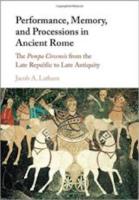
CUP (2016) h/b 345 pp. £74.99 (ISBN 9781107130715)
The pompa circensis, the procession through Rome from the Capitoline Hill down to the Circus Maximus via the Roman Forum and the Temple of Ceres, was held prior to the chariot racing events at annual festivals such as the ludi Apollinares or the ludi Megalenses. It was performed multiple times per year for hundreds of years (perhaps from the early Republic through to the sixth century AD). Despite its duration over time, its frequency, the enormous crowds that viewed it, and its importance in Roman society as an opportunity for the elite to attain public visibility and the concomitant honour and prestige, the pompa circensis has received comparatively little scholarly attention, especially when compared with the triumph or the public funeral procession.
This monograph by Jacob Lantham comprises a highly professional and scholarly (38 pages of bibliography) study of the available evidence for the circus procession. It sets out not just to reconstruct the elements of the procession from the available evidence but to provide a theoretical framework in which to assess the significance of the pompa both for the viewing public and for the praeses ludorum who funded it. It aims to establish what was in the procession (images of gods) and what landmarks lined the route, while plotting the changing nature of the procession over time.
The source material for the pompa circensis is limited and problematic. It consists essentially of a paragraph in Dionysius of Halicarnassus (who borrowed from Fabius Pictor), Ovid Amores 3.2, the occasional oblique reference in other texts, and some tendentious representations on coins. So the text is densely argued: L. of necessity must explore subtle and speculative lines of enquiry which need to be supported by academically valid and persuasive arguments, and this cannot easily be done without a certain amount of jargon (readers can expect, for example, ‘a semiotic analysis of the phenomenology of the procession’).
The introduction outlines what can and cannot be achieved on the basis of the evidence, and after that the book divides into two parts, which roughly correspond to Republic / Empire. The circus procession plays a fascinating role in this transition to autocracy. In 45 BC an ivory image of Julius Caesar began to be conveyed in circus processions alongside images of the gods. L. suggests that this blurring of human and divine status may in part have influenced the assassins to act in 44 BC. Ironically, after Caesar’s death, his adopted son Octavian ensured that the deified Caesar’s image continued to be paraded at the pompa circensis, setting a long lasting precedent for the display of images of deceased emperors.
The quality of the book production is very high, the figures and maps are particularly fine, but this comes at a cost. At approximately £75 it is likely that only specialist will want to invest in a copy, but this is certainly an impressive work of scholarship.
Giles Gilbert—Woodbridge School
